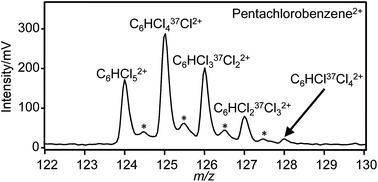Suppression of fragmentation in multiphoton ionization mass spectrometry using a near-infrared femtosecond laser as an ionization source
Abstract
The ionization and fragmentation processes for pentachlorobenzene were examined using a femtosecond laser emitting at 400, 800, and 1200 nm. A molecular ion was clearly observed in the mass spectrum, since the molecule can be directly ionized from the singlet electronic exited state before relaxation to triplet levels, because the pulse width of the laser is shorter than the lifetime of the excited state. Fragmentation was minimal at 1200 nm, in contrast to ionization at 800 and 400 nm. Indeed, a doubly-charged molecular ion was prominent at 800 nm, owing to the absorption band of the singly-charged molecular ion at this wavelength. Fragmentation was further enhanced at 400 nm, which can be explained by the dissociation of the doubly-charged molecular ion having a larger absorption band at 400 nm. Fragmentation was strongly affected by the absorption character of the ionic species, i.e., singly- and doubly-charged molecular ions, appeared in the process of multiphoton ionization.



 Please wait while we load your content...
Please wait while we load your content...